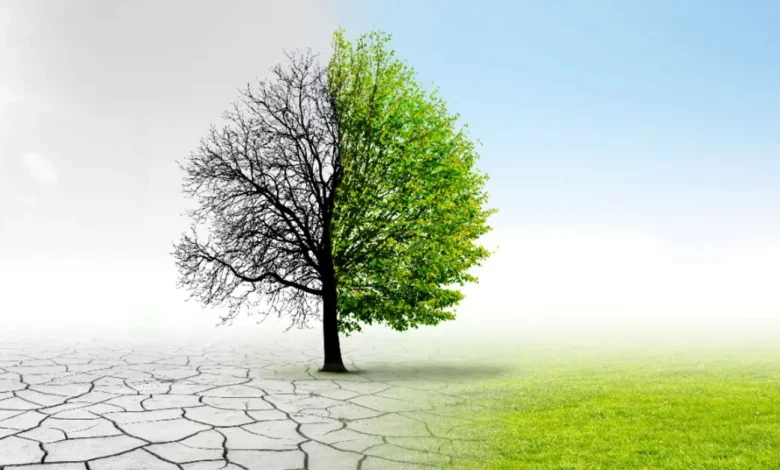Should India set a higher bar to address Climate Change?
[GS Paper 3 - Conservation, Environmental Pollution and Degradation]

Context – The urgency to address climate change has reached a pivotal juncture as nations convene for the 28th Conference of the Parties (COP28). Against the backdrop of escalating environmental crises, the question arises: Should India set a higher bar to address climate change, and how will this be reflected in the agreements negotiated at COP28? This editorial delves into the complex landscape of climate commitments, exploring India’s role in setting ambitious targets, the implications of such actions, and the broader global context of COP28 agreements.
COP28 saw a historic shift as all 198 signatories agreed to “transition away” from all fossil fuels, moving beyond the earlier emphasis on coal. India played a crucial role in modifying language at COP26 and supported the UAE Consensus at COP28, signaling a departure from coal-centric agreements.
India’s Current Climate Commitments:
India, as a signatory to the Paris Agreement, has committed to reducing its carbon intensity and increasing the share of non-fossil energy capacity in its energy mix. The nation has made notable strides in expanding its renewable energy capacity, with a particular focus on solar and wind power. However, the intensification of climate-related challenges necessitates a critical evaluation of whether India’s current commitments align with the scale of the crisis.
Case for Setting a Higher Bar:
- Global Leadership and Responsibility: As one of the world’s largest and fastest-growing economies, India’s actions carry global significance. Advocates for setting a higher bar argue that India, given its demographic and economic weight, should take a leadership role in the fight against climate change. This involves not only meeting current commitments but surpassing them to set an example for other nations.
- Vulnerability and Adaptation: India is highly vulnerable to the impacts of climate change, with millions at risk from extreme weather events, sea-level rise, and changing agricultural patterns. Elevating climate commitments would entail a stronger emphasis on adaptation measures, including the development of resilient infrastructure, sustainable agricultural practices, and robust disaster management strategies.
- Economic Opportunities: Setting a higher bar for climate action can be viewed as an economic opportunity rather than a burden. Investments in renewable energy, energy efficiency, and sustainable practices not only reduce carbon emissions but also stimulate economic growth, create jobs, and position India as a global leader in emerging green industries.
- International Diplomacy: By setting more ambitious climate goals, India can enhance its standing on the international stage. This not only fosters goodwill but also positions India to influence global climate policies. Given the interconnected nature of climate change, collaborative efforts become imperative, and India’s leadership can catalyze broader international cooperation.
COP28 Agreements and India’s Role:
As the world converges at COP28 to negotiate and finalize climate agreements, India’s role becomes pivotal in shaping the trajectory of global climate action. The agreements emerging from COP28 will likely encompass a range of issues, from emission reduction targets to adaptation financing and technology transfer. India, in navigating these negotiations, faces a delicate balancing act between asserting its developmental imperatives and contributing meaningfully to the global climate effort.
- Emission Reduction Targets: India’s stance on emission reduction targets will be closely scrutinized at COP28. While advocates push for more ambitious commitments aligned with the urgency of the climate crisis, India must consider its developmental priorities. Negotiating equitable burden-sharing among nations, especially between developed and developing countries, will be a central theme.
- Adaptation and Resilience: COP28 agreements should address the specific vulnerabilities faced by developing nations, including India, and allocate adequate resources for adaptation and resilience-building measures. India, with its vast population and diverse geographical challenges, must advocate for a fair distribution of adaptation funds and technology transfer.
- Technology Transfer and Capacity Building: A key aspect of India’s climate strategy revolves around technology transfer and capacity building. As the nation seeks to transition to a low-carbon economy, agreements at COP28 should facilitate the transfer of clean technologies and provide support for building the necessary infrastructure and skills.
- Global Solidarity: India’s participation in COP28 provides an opportunity to emphasize the principle of common but differentiated responsibilities. While acknowledging the global nature of the climate crisis, India can advocate for a fair and just transition that considers each nation’s historical contributions to greenhouse gas emissions.
Conclusion:
In conclusion, the question of whether India should set a higher bar to address climate change is intricately linked to the negotiations and agreements emerging from COP28. The imperative for climate action is undeniably urgent, and India’s role is central to striking a balance between national development goals and global climate responsibilities.
As the world watches COP28 unfold, India has the opportunity to not only elevate its climate commitments but also shape a more equitable and sustainable future. The decisions made at COP28 will reverberate globally, and India’s leadership can contribute significantly to charting a course towards a resilient and low-carbon world.
SOURCE: The Hindu





.png)



